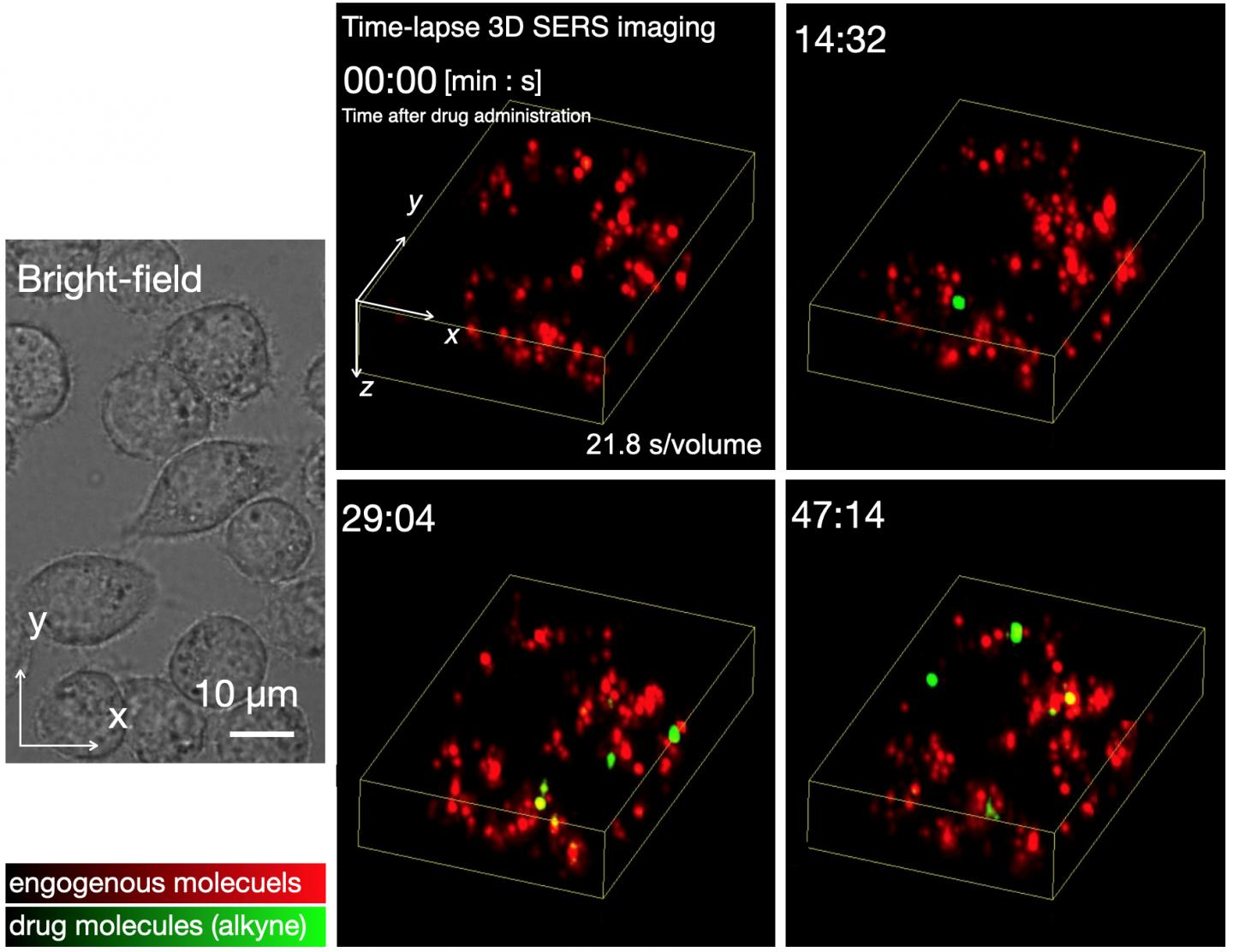Nov 19 2020
The quality of life of people around the world has been considerably influenced by successful drug development.
 Time-lapse 3D SERS imaging of small-molecule uptake by live cells. We successfully observed that the SERS signals of alkynes were initially detected around 10 to 15 min after drug administration, and the number of the signals gradually increased over time. The drug administration concentration was 20 μM. Image Credit: Osaka University.
Time-lapse 3D SERS imaging of small-molecule uptake by live cells. We successfully observed that the SERS signals of alkynes were initially detected around 10 to 15 min after drug administration, and the number of the signals gradually increased over time. The drug administration concentration was 20 μM. Image Credit: Osaka University.
The ability to monitor how molecules move into target cells and visualizing their action once they are inside is essential to determine the best candidates.
Hence, analysis methods form an essential part of the drug discovery process. Working together with RIKEN, scientists from Osaka University have reported a Raman microscopy-based procedure for observing small-molecule drugs that involves using gold nanoparticles. The results of the study have been reported in the ACS Nano journal.
In general, small drug molecules are tracked by binding them with fluorescent probes that become visible upon irradiation with light. Then, microscopy can be utilized to observe such molecules within the cells in real-time.
But fluorescent molecules can be heavy and can impact the behavior of the small molecules. Moreover, certain fluorescent molecules tend to lose their fluorescence upon over-exposure light, which makes it hard to see them during long studies.
A much smaller tag called an alkyne, composed of carbon-carbon triple bonds, is one alternative to fluorescent labels.
The specific arrangement of atoms in alkynes does not occur naturally in cells; thus, they offer a highly specific marker. Moreover, their small size implies that alkynes have the least impact on small-molecule behavior.
Rather than emitting fluorescence in the presence of laser light, alkynes produce what is called a Raman signal, which can be clearly determined amongst the cell material signals.
But it is extremely difficult to identify the Raman signal of alkyne groups when there are not many around due to the low efficiency of Raman scattering. Hence, the team has integrated alkyne-tagging with gold nanoparticles.
Surface-enhanced Raman scattering (SERS) microscopy can excite gold nanoparticles to produce improved electric fields that strengthen the Raman signal of the alkyne groups, thereby making them simpler to detect.
Our approach is a combination of techniques that have been used for tracking small molecules in live cells. Gold nanoparticles are particularly useful messengers for reporting the presence of alkyne groups because they enhance the alkyne signal, as well as providing a surface that the alkynes like to interact with. The two components therefore come together naturally to generate the enhanced signal.
Kota Koike, Study Lead Author, Osaka University
Gold nanoparticles are easily absorbed by different types of cells, which makes the method widely applicable. The nanoparticles access the lysosome compartments present within the cell and improve the signal of the alkyne-tagged molecules that later reach the lysosomes and interact with them.
Our SERS technique has the potential to be used with a variety of different cell types as well as a virtually limitless number of drug candidates. This is particularly exciting for drug discovery where any means of better understanding drug dynamics in real time is extremely valuable for development.
Katsumasa Fujita, Study Corresponding Author, Osaka University
Journal Reference:
Koike, K., et al. (2020) Quantitative Drug Dynamics Visualized by Alkyne-Tagged Plasmonic-Enhanced Raman Microscopy. ACS Nano. doi.org/10.1021/acsnano.0c05010.